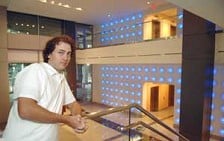A glowing masterpiece illuminates downtown
.floatimg-left-hort { float:left; } .floatimg-left-caption-hort { float:left; margin-bottom:10px; width:300px; margin-right:10px; clear:left;} .floatimg-left-vert { float:left; margin-top:10px; margin-right:15px; width:200px;} .floatimg-left-caption-vert { float:left; margin-right:10px; margin-bottom:10px; font-size: 12px; width:200px;} .floatimg-right-hort { float:right; margin-top:10px; margin-left:10px; margin-bottom:10px; width: 300px;} .floatimg-right-caption-hort { float:left; margin-right:10px; margin-bottom:10px; width: 300px; font-size: 12px; } .floatimg-right-vert { float:right; margin-top:10px; margin-left:10px; margin-bottom:10px; width: 200px;} .floatimg-right-caption-vert { float:left; margin-right:10px; margin-bottom:10px; width: 200px; font-size: 12px; } .floatimgright-sidebar { float:right; margin-top:10px; margin-left:10px; margin-bottom:10px; width: 200px; border-top-style: double; border-top-color: black; border-bottom-style: double; border-bottom-color: black;} .floatimgright-sidebar p { line-height: 115%; text-indent: 10px; } .floatimgright-sidebar h4 { font-variant:small-caps; } .pullquote { float:right; margin-top:10px; margin-left:10px; margin-bottom:10px; width: 150px; background: url(http://www.dmbusinessdaily.com/DAILY/editorial/extras/closequote.gif) no-repeat bottom right !important ; line-height: 150%; font-size: 125%; border-top: 1px solid; border-bottom: 1px solid;} .floatvidleft { float:left; margin-bottom:10px; width:325px; margin-right:10px; clear:left;} .floatvidright { float:right; margin-bottom:10px; width:325px; margin-right:10px; clear:left;} Glowing like fireflies on a hot summer night, the artwork inside the atrium of the new Davis Brown Tower on the corner of 10th and Walnut streets is the epitome of the old saying, “One man’s junk is another man’s treasure.”
Having claimed ownership to more than 200 glass washing machine domes to prevent them from building amass in a landfill, a Kansas City, Mo.-based artist who goes professionally by the name Stretch took the orphaned domes and made them his treasure, resulting in an eye-catching artistic display in downtown Des Moines years later.
“Normally I work with glass, and a lot of my sculpture is out of glass,” he said, “glass and stone, glass and wood – trying to find the balance between the glass and the other material. You try to find that harmony; that yin and yang; the fragile, the durable.”
Origins of the domes
So when the opportunity arose to receive more than 200 glass domes from Maytag Corp. in Amana, Stretch eagerly accepted, and before he knew it, had a semitrailer truck beeping in reverse at his Kansas City studio.
Accidentally, Maytag had ordered the wrong size of glass viewing domes from Swedish-based manufacturer Electrolux Home Products Inc. for its washing machines, and was left with two semi loads of oversized glass domes.
Without any room to store the domes, and with no plans to redesign the washing machine, Maytag was faced with a predicament.
But with one swift call to the Iowa Waste Exchange, a program of the Iowa Department of Natural Resources, Maytag was able to find an owner for the unwanted domes.
Waste Exchange personnel remembered doing business with Moberg Gallery and recalled an artist who worked mainly with glass materials, so Moberg connected with Stretch and the domes were headed south, said Jackie Moberg, co-owner of Moberg Gallery.
But it wasn’t until a couple of years later that the domes were put into a project bid that would bring them back to Iowa, and that was the art bid for the Davis Brown Tower.
Winning the bid
“We were in the design construction phase and we were getting down to picking out elevators and looking at final finishes in the lobby,” said Dennis Reynolds, design director at Ladco Development Inc., who worked on the project, “and things were being thrown out like, ‘Oh maybe we could put some tile, or wood paneling on (the 55- by-26-foot wall)’ and several of us said, ‘You know, why don’t we let the wall be the wall and have it be a piece of art with an extra layer of meaning to it.'”
So with plenty of space to fill – 1,430 square feet to be exact – Reynolds called Moberg Gallery and asked Jackie and TJ Moberg to join the project as the art consultants and find an artist who could turn a bare wall into a masterpiece.
“We wanted something that would be both challenging for folks but appeal to a broad range of people and a broad range of understanding,” Reynolds said.
With that in mind, Moberg Gallery put out a call for proposals to its artists and presented more than 10 ideas to the selection committee that Ladco had coordinated.
It was up to the selection committee, which included people from the Davis, Brown, Koehn, Shors & Roberts P.C. law firm, RDG Planning & Design and Ladco, to narrow the 10 proposals down to three. The selection committee chose their favorite: Strech’s Maytag dome creation.
Stretch’s proposal called for a piece composed of 190 sand-blasted washing machine domes in a linear pattern across the wall, with individual light-emitting diode (LED) lights glowing behind each dome.
“We really felt like we were getting a lot of value,” Reynolds said.
“With these types of pieces, you don’t pick the low bidder, so to speak, but indeed because (the material in Stretch’s piece) was recycled, we were being good stewards to the land and it would have been much more expensive if we would have had to make all those glass pieces, and I think that was a nice aspect that appealed to us.”
And being a steward to the environment was an aspect that appealed to Stretch as well, and it was Iowa’s environment that gave him the inspiration for the design.
“The grid really came from when I fly down the highway in Iowa,” he said.
“All the cornfields and the crops that you see – you get these big linear lines when you drive by. So everything started falling into place with Iowa and corn and growth and recycling.”
Building a masterpiece
So after his proposal was chosen by the selection committee, Stretch immediately began construction on the piece.
Knowing the dimensions of the wall and having seen photographs of the space he was working with, Stretch emulated the Davis Brown wall in his studio and tried to do as much work as he could there to cut back on installation time.
To begin, he built 27 ultra-light wood panels that would be anchored to wall in the Davis Brown Tower, and drywalled each panel, mounting a retaining ring on the panels for all 190 domes. Then he ensured that every panel had enough holes so wiring could be run through to each individual dome.
After the construction of the wall paneling was complete at his studio, Stretch shipped the panels to Des Moines for workers to start anchoring them to a substructure on the wall in the Davis Brown Tower. After taping and mudding, the panels were securely in place and ready for the domes to be installed, Stretch said.
“You try to figure out how to do it efficiently,” he said. “That’s why we built the wall in Kansas City and shipped it separately.”
So approximately a month after the wall panels were shipped, Stretch and three workers arrived in Des Moines to do a two-day installation of the glass domes, with each having an individual LED light wired inside.
Interactive activity
“(The LEDs) activated the space,” Stretch said. “They reflect off all the glass, off the interior. It draws attention to the location.”
Stretch explained that the art piece not only captivates the audience inside the building, but also captivates the audience walking by, driving by or even the people inside the nearby Hotel Fort Des Moines.
“It’s fun when you’re walking down 10th Street, or coming and going from Hotel Fort Des Moines, you can look across there and see light,” Reynolds said.
And plenty of light there will be. With each dome having an individually programmed LED light, the art display not only activates the space, but can also be interactive. The Mobergs said that every single light in the artwork is controlled by a computer program that allows each light to be programmed into a different color, making possibile more than 16 million color combinations.
Reynolds said he even talked with the electricians about dimming the lighting in the atrium to allow the artwork to have more of a presence.
“We worked with the lighting designer to reduce the light in the lobby,” Reynolds said. “We actually took out about a third of the lights in the lobby, and interestingly enough, nobody said, ‘Wow, this lobby is dark,’ because the piece is so exciting.”









